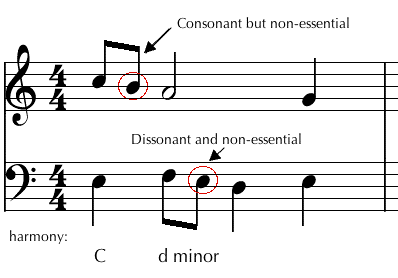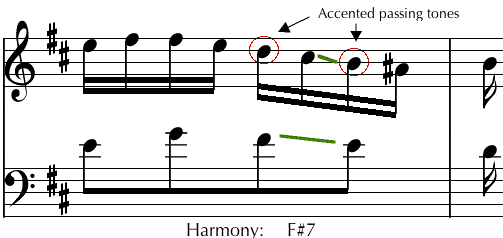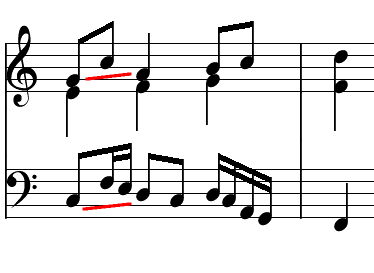Answer: You've hit on something that I think troubles the sleep of many counterpoint students. What exactly is a "non-essential tone" - is it the same as a dissonance?
The term itself implies, first of all, that one is dealing with tonal counterpoint. In tonal counterpoint there is at all times a prevailing harmony. 18th century polyphony (e.g. Bach and successors) is built on harmony, while the counterpoint of 16th century artists like Palestrina is formed from melodic lines with harmony as a result. As Knud Jeppeson says in his Counterpoint, "Palestrina starts out from lines and arrives at chords; Bach's music grows out of an ideally harmonic background..."
In tonal counterpoint an "essential tone" is a tone that belongs to that intended harmony. A nonessential tone may or may not be dissonant, but it isn't part of the chord. For example, the "B" in the upper voice below is consonant with the E in the bass, but it is not part of the C chord that clearly is intended on beat one; it's a non-essential tone. The E in the bass on beat two is not part of the implied d minor chord and so is non-essential, but in this case it's also a dissonance (a fourth formed with the bass is treated as a dissonance).

For parallels, you're referring to one of the exceptions: normally it's not so good to move both voices of a perfect interval directly to another perfect interval, but it is sometimes done in tonal counterpoint if one of the notes is non-essential. In this example from Scarlatti, quoted by Kent Kennen in his own Counterpoint, there are parallel fifths between the F# and E of the lower voice and the C# and B of the upper one, but it's all OK because the B is non-essential; it's not part of the F#7 chord outlined in the second half of the measure:

This is not related to the separate "rule" about parallels between adjacent beats; that's a stricter standard of parallelism - if one is being careful then one wants to avoid not only parallels between adjacent notes, but even parallels between notes that stand out because they're on adjacent beats, even if some less-important notes come between:

But once again those would be acceptable in tonal counterpoint if at least one of the parallel tones was non-essential. The above example is not going to win awards in any case, but it's especially harmed by the parallels between beats one and two; all four notes of those parallel fifths are essential to their respective chords.

